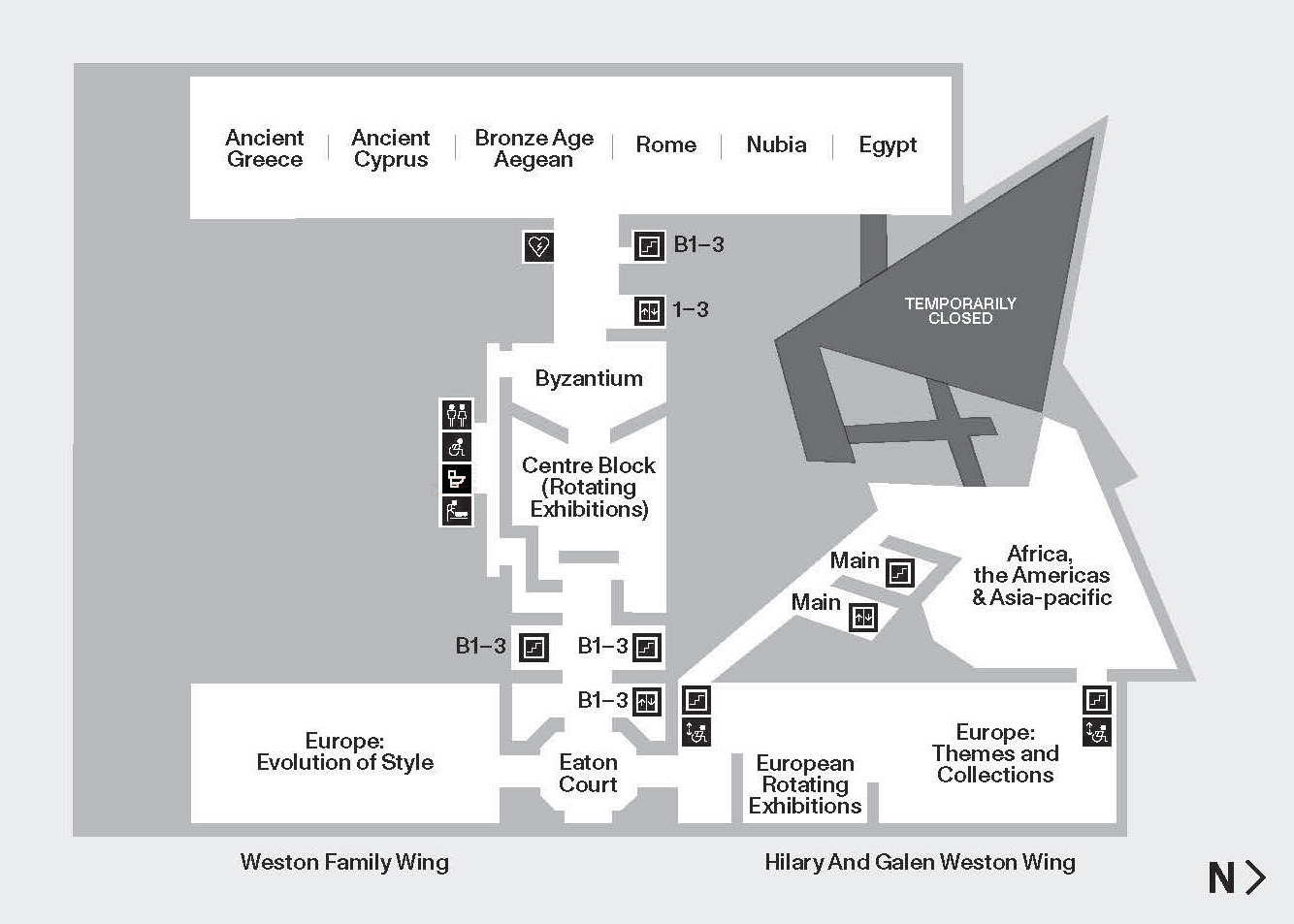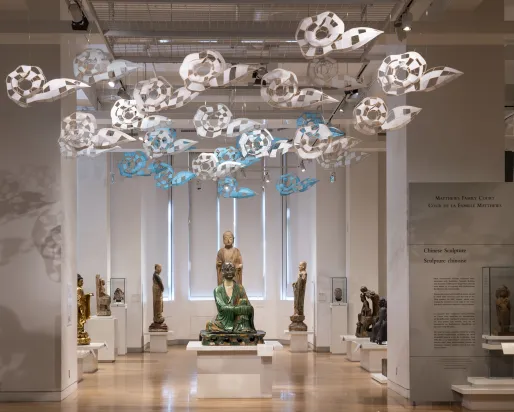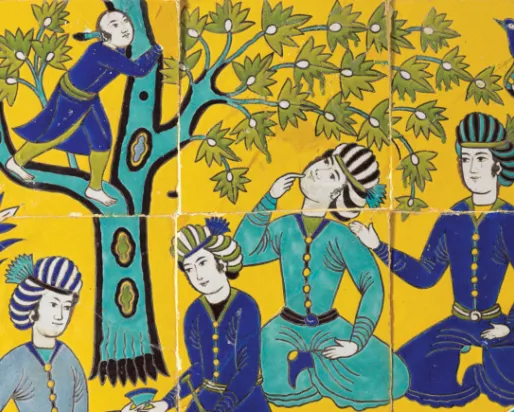Anishinaabeg
Art & Power
Date
Location
About
Explore the life, traditions, and sacred stories of the Anishinaabeg as told through their powerful art over the last two centuries. Anishinaabeg: Art & Power takes you on a journey through the artistic evolution of one of the most populous and diverse Indigenous communities in North America.
With their homeland in Ontario, and communities stretching from Quebec to Alberta and Michigan to Montana, the Anishinaabeg have communicated and expressed their knowledge and cultural traditions through art for centuries, depicting the relationships between humans, their ancestors, nature, ceremony and supernatural beings known as spirits. Over time, their art was deeply influenced by both inter-community relationships with other Indigenous groups and the arrival of the Europeans to Canada. From early art forms and intricate beaded regalia to paintings and drawings from the Woodlands School art movement, these richly colourful and vibrant pieces reveal the artistic transformation of Anishinaabeg art. By showcasing the great beauty and power of this cultural history, Anishinaabeg: Art & Power highlights the shared connections among Indigenous groups, and between Indigenous and non-Indigenous Canadians.
See these stunning works steeped in tradition, and gain a greater understanding of Indigenous art forms, beliefs and worldviews.
Co-Curators

Arni Brownstone
Assistant Curator
Royal Ontario Museum
Arni’s curatorial responsibilities at the Museum primarily rest in the North American plains, southwest U.S., and Latin American ethnographic collections. He curated the sections pertaining to those collections in both ROM’s Daphne Cockwell Gallery dedicated to First Peoples art & culture and The Shreyas and Mina Ajmera Gallery of Africa, The Americas, and Asia-Pacific. He is currently responsible for the entirety of the Museum’s ethnology collections of the Americas. Arni is ROM’s curator of Anishinaabeg: Art & Power, collaborating with two Indigeneous guest curators.
Arni joined ROM in 1974 as an aspiring painter with an undergraduate degree in Fine Arts from York University. Before that he had worked in several contemporary art galleries including the Isaacs Gallery, Carmen Lamanna Gallery, and La Galerie du Siécle. He also worked summers in Manitoba and Saskatchewan’s remote Indigenous communities. Against this background, Arni’s primary task for his first 10 years at ROM was the physical reorganization of its collection of over 30,000 ethnographic artifacts from around the world. Handling these objects had a profound effect on both his painting and research interests. In 1982, he received a Canada Council “B” grant, allowing him to paint full time for a year and travel to European museums where he studied ethnographic collections. This experience enhanced Arni’s understanding of the distribution of geometric motifs having a worldwide presence in ethnographic art. This trip was a turning point that several years later led to his giving up painting in favour of studying museum objects.
Since the mid 1980s, Arni’s research has largely focussed on the material culture of the North American Great Plains. This has followed two paths, with one primarily directed toward specific collections, deepening our knowledge of museum objects, so that they may speak more eloquently about the history and culture of the people that produced them. The other is a more specialized study with the long-term goal of describing the art history of the known corpus of pictographic paintings o the plains. Both lines of research depend on the ethnohistorical approach and on primary archival sources, but the latter principally hinges on stylistic analysis based on the comparative method. Arni has published numerous articles in both areas, as well as the books “War Paint”, published in 1993 by ROM Press an “War Paintings of the Tsuu T’ina Nation”, co-published by the University of Nebraska Press and University of Albert Press in 2015. That same year, he edited and contributed to a book on ROM’s sixteenth century Indigenous document from Mexico d the , “The Lienzo of Tlapiltepec”, co-published by ROM Press and the University of Oklahoma Press.
Saul Williams
Co-Curator
Education Director, North Caribou Lake Education Authority
Saul Williams was born in North Caribou Lake called Neehakooyank (Where the Tree Leans over Calm Waters) in spring1954. His family moved to Weagamow Lake to live in North Caribou Lake First Nation Reserve where he became a Band Member.
In the summer of 1968, Saul met Dr. Mary Black. He and his friends performed chores for her including carrying wood and water and translating for Elders who came to visit her. For his efforts, Saul was happy to be paid in spaghetti and meat balls. Having seen him constantly doodling and sketching, Mary brought Saul tubes of acrylic paint on one of her trips down south. With her go-ahead, Saul painted her wall and finished his first painting of a stylized raven for which he was paid five dollars. This painting—Saul’s first sale—is in the Museum's collections.
For most of his younger years, before he was a labourer and, eventually, a school counsellor, Saul made his living by selling artwork. In 1984, he was one of the first Indigenous artists to have an exhibition at the Art Gallery of Ontario (AGO).
Saul is currently an education director with the North Caribou Lake Education Authority. Working closely with parents and the community’s leadership, he continues to advocate for the inclusion of Aboriginal knowledge, language, traditions, and culture in the school’s program. While doing so, Saul works within the requirements of the Education Funding Agreement with the Federal Government as well as the Ministry of Education. Saul firmly believes Aboriginal teachings and values are integral to the community.
Alan Corbiere
Co-curator
Lakeview School, M’Chigeeng First Nation on Manitoulin Island
Alan is a Program Coordinator, Anishinaabemowin Revitalization Program, Lakeview Elementary School, M’Chigeeng, on Manitoulin Island, Ontario. He is also a curator, writer and editor, historical researcher, public speaker at conferences and events, and teacher.
Alan’s first job as curator came in 2001 at the Ojibwe Cultural Foundation, where he researched, developed, and curated an exhibition on the residential school experience. He organized workshops for residential school survivors to create works of art to process their healing. An accompanying catalogue called “Remembrance, Reflection, Rejuvenation: Healing from the residential school experience through the arts” was published by the Ojibwe Cultural Foundation.
Alan next curated The Sword of Mookomaanish aka ‘Chief Little Knife’ showcasing a silver mounted sword presented to Odawa Chief Mookomaanish in 1815 for his bravery and compassion during the War of 1812. Alan’s other exhibitions have included The Manitoulin Treaty of 1862 (2002) which commemorated the 140th anniversary of the Treaty’s signing and featured excerpts from petitions and treaty councils alongside reproductions of historic portraits of chiefs, many originally painted by Paul Kane in 1845. His next exhibit was Gchi-Miigisaabiigan ‘The Great Wampum of 1764’ which included photographic reproductions, excerpts from recorded speeches, and replica wampum belts. The wampum belts symbolize the Anishinaabe-British relationship and serve as the basis for the treaty in which the British promised to deliver ‘Indian presents’ to the Anishinaabeg and allied tribes. These exhibits, developed prior to formal training, were well-received by the community and led Alan to pursue museological, archival, and oral tradition research. For the last decade, Alan’s career has focused on trying to use all three disciplines to create a more holistic version of the Anishinaabe story.
Partners & Sponsors






